The Introduction to 3D Stereolithography (SLA)
(2022年11月17日)https://www.lcrapid.com/the-introduction-to-3d-stereolithography-sla.html
The most commonly used technology in 3D printing is stereolithography, which is applied to create models, prototypes, patterns, etc. Next, we will introduce 3D stereolithography technology to you.
I. What is 3D stereolithography (SLA)
Research in the field of 3D stereolithography was carried out in the 1970s, but the term was created by Chuck Hull in 1984. At that time, he applied for a patent for the process, which was granted in 1986. 3D stereolithography can be used to manufacture products such as product prototypes, medical models, computer hardware and many other applications. Because stereolithography technology can print fast and generate almost any design, SLA series molding machines occupy a large share of the 3D printing and manufacturing equipment market.
SLA process is based on the principle of photopolymerization of liquid photosensitive resin. Under the irradiation of UV light with a certain wavelength (325 or 355 nm) and intensity (w =10-400mw), this liquid material can rapidly undergo photopolymerization reaction, and the molecular weight increases rapidly, then the material changes from liquid to solid. The liquid bath is filled with liquid light-cured resin. The laser beam can scan on the liquid surface under the action of the deflecting mirror. The scanning track and the presence or absence of laser are controlled by computers. The place where the liquid is scanned by the light spot will solidify. At the beginning of molding, the working platform is at a certain depth below the liquid surface, and the liquid surface is always in the focal plane of the laser. After focusing, the light spot will scan the liquid surface point by point according to the instructions of the computer, that is, point-by-point solidification. When a layer of scanning is completed, the unexposed area is still liquid resin. Then the lifting platform drives the platform one layer down, and the formed layer is covered with another layer of resin. The scraper will scrape the resin liquid level with high viscosity evenly, and then the scanning of the next layer will be continued. The newly solidified layer will firmly adhere to the previous layer. This process will be repeated until the whole part is manufactured, and a three-dimensional solid model will be obtained.
II. A brief history of stereolithography
Stereolithography is an early widely used 3D printing technology. In the early 1980s, Hideo Kodama, a Japanese researcher, first invented the modern layered stereolithography technology by using UV-cured photosensitive polymers.
However, the term stereolithography was created by Chuck Hull when he submitted the patent of the process in 1984. The patented stereolithography technology of Chuck Hull is a method to create 3D objects by continuously printing thin layers of objects from the bottom to the top using a medium that can be cured by UV light. Hull's patent describes a process that a beam of concentrated ultraviolet light focuses on the surface of a barrel filled with liquid photopolymers. The beam focuses on the surface of the liquid photopolymer, and each layer of the desired 3D object is produced by crosslinking (creating intermolecular bonds in the polymer). His invention aimed to enable engineers to create prototypes of their designs in a more efficient way. After obtaining a patent in 1986, Hull co-founded 3D Systems, the first 3D printing company in the world, and commercialized it.
The success of stereolithography technology in the automotive industry has established the industry status of 3D printing, and innovation uses of this technology is continuously applied in many research fields. Now we are trying to build a mathematical model of the stereolithography process and design algorithms to determine whether 3D printing and manufacturing can be used to construct the proposed object.
III. Why choose SLA 3D printing?
1. It has the longest development history, the most mature technology and the most extensive application. Among the rapid molding machines installed all over the world, the UV-cured molding system accounts for about 60%.
2. The molding speed is fast and the system is stable.
3. It is highly flexible.
4. The precision is very high, which can achieve micron level, such as 0.025mm.
5. Good surface quality and smoothness make it suitable for fine parts.
3D-printing-2.jpg
IV. Material types commonly used in stereolithography
1. Engineering plastics
Engineering plastics are widely used 3D printing materials applied to FDM equipment. They are plastics with excellent strength, impact resistance, heat resistance, hardness and aging resistance. Engineering plastics include thermoplastic materials and thermosetting materials.
2. Photosensitive resin
Photosensitive resin is generally in a liquefied state, and objects printed with this material generally have high strength, high temperature resistance, water resistance and other characteristics.
The specific characteristics of photosensitive resin are as follows: low viscosity; small curing shrinkage; fast curing rate; small swelling; high photosensitivity; high curing degree; high wet strength. The properties are stable before curing, which makes the transportation and storage easy, and there is no dark reaction. Due to its fast curing speed, the photosensitive resin has excellent surface dry property, and the product appearance is smooth after molding, which can be transparent to translucent frosted. Due to its good liquid fluidity and instantaneous photocuring property, liquid photosensitive resin has become the preferred material for stereolithography consumables in high-precision product printing.
3. Metal materials
Metal materials for stereolithography exist in the forms of metal powder, metallic foil and metal wire. At present, the market share of metal materials is small, but the expansion speed is fast. If metal materials are added to some engineering plastic materials (such as ABS), wires with certain metal properties that are suitable for FDM models can be made.
4. Ceramic materials
Aluminosilicate ceramic powder can be used for the stereolithography of ceramic products. Ceramic powder is usually in powder form and generally used in selective laser sintering (SLS) printers. The ceramic powder for stereolithography is a mixture of ceramic powder and a certain binder powder.
Ceramic materials have the advantages of high strength, high temperature resistance and corrosion resistance, which enable them have potential applications in aerospace and automotive fields. At the same time, there are various colors of ceramic materials for selection, so vivid and colorful products can be printed with ceramic materials. Ceramic materials are ideal choices for handicrafts, architecture and sanitary products.
Compared with the traditional manufacturing technology, the ceramic stereolithography technology using ceramic materials has faster molding speed, is free from the shackles of the mold, and does not depend on the complexity of the parts; the traditional ceramic manufacturing technology can only produce products with simple structures, and has the disadvantages of high cost and long production cycle. Instead, the ceramic stereolithography technology can make up for the shortcomings of traditional ceramic manufacturing technology with its simple operation, high speed and high precision. At present, ceramic stereolithography technology is mainly used in industrial products, jewelry / luxury goods, medical industry, etc. Of course, it is also an essential technology for universities and research institutes engaged in scientific research.
5. High polymer materials for biological use
High polymer materials for biological use mainly include scaffold materials and direct cell printing materials. Scaffold materials should meet the following requirements: They shouldhave good biocompatibility but no toxicity to cells and body; good biodegradation characteristics ensure that they can be completely degraded and absorbed by the body or excreted from the body; the materials should have good mechanical properties, certain mechanical strength and plasticity, so the structure can be stable for a long time with high porosity; a good surface compatibility is conducive to cell adhesion and growth on the material surface.
V. Applications of SLA 3D printing
SLA 3D printing technology can be used in product development and the creation of prototypes (concept, geometry, vision, functional model) in mechanical engineering, especially in automobile industry and medicine.
Since the 1990s, stereolithography models have been used in medicine to create accurate 3D models of various anatomical regions of patients based on data from computer scanning. Stereolithography models can also be used in auxiliary diagnosis, preoperative planning as well as implant design and fabrication.
It is expected that the use of stereolithography equipment in the direct production of terminal products (rapid manufacturing) will increase in the next few years.
LC Rapid is a professional rapid prototyping factory, we provide 3d printing china manufacturing, sheet metal fabrication automotive, low volume manufacturing and etc. Want to know more? Please contact us.
- このできごとのURL:




コメント